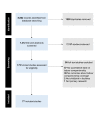From global recommendations to (in)action: A scoping review of the coverage of companion of choice for women during labour and birth
- PMID: 36963069
- PMCID: PMC10021298
- DOI: 10.1371/journal.pgph.0001476
From global recommendations to (in)action: A scoping review of the coverage of companion of choice for women during labour and birth
Abstract
Women greatly value and benefit from the presence of someone they trust to support them throughout labour and childbirth ('labour companion of choice'). Labour companionship improves maternal and perinatal outcomes, including enhancing physiological labour and birth experiences. Despite clear benefits, implementation is slow. We conducted a scoping review to assess coverage and models of labour companionship, including quantitative studies reporting coverage of labour companionship in any level health facility globally. We searched MEDLINE, CINAHL, and Global Health from 1 January 2010-14 December 2021. We extracted data on study design, labour companionship coverage, timing and type of companions allowed, and recoded data into categories for comparison across studies. We included data from a maternal health sentinel network of hospitals in Latin America, using descriptive statistics to assess coverage among 120,581 women giving birth in these sites from April 2018-April 2022. In the scoping review, we included 77 studies from 27 countries. There was wide variation in the coverage of labour companionship: almost one-third of studies reported coverage less than 40%, and one-third of studies reported coverage between 40-80%. Husbands or partners were the most frequent companion (37.7%, 29/77), followed by family member or friend (gender not specified) (32.5%, 25/77), family member or friend (female-only) (13.0%, 10/77). Across nine sentinel hospitals in five Latin American countries, there was variation in coverage, with no companion at any time ranging from 14.9%-93.8%. Despite the well-known benefits and factors affecting implementation of labour companionship, more work is needed to improve equitable coverage. Concerted efforts are needed to engage with communities, health workers, health managers, and policy-makers to establish policies, address implementation barriers, and integrate data on coverage into perinatal records and quality processes to ensure that all women have access. Harmonized reporting of labour companionship would greatly enhance understanding at global level.
Copyright: © 2023 Bohren et al. This is an open access article distributed under the terms of the Creative Commons Attribution License, which permits unrestricted use, distribution, and reproduction in any medium, provided the original author and source are credited.
Conflict of interest statement
MAB, BDM, öT, and AP have participated in the development of guidelines, research, and materials related to companion of choice at birth. The authors have declared that no other competing interests exist.
Figures
References
-
- World Health Organization. WHO recommendations: intrapartum care for a positive childbirth experience. World Health Organization; 2018 2018. Report No.: 978-92-4-155021-5. - PubMed
-
- World Health Organization. WHO recommendations on health promotion interventions for maternal and newborn health Geneva, Switzerland: World Health Organization; 2015. - PubMed
-
- World Health Organization. WHO recommendations for augmentation of labour. Geneva, Switzerland: World Health Organization; 2014.
Publication types
Grants and funding
LinkOut - more resources
Full Text Sources
Miscellaneous

